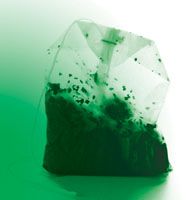Iced tea
Green tea is drunk by many for the health benefits of the antioxidant catechins, which are thought to help fight heart disease and other conditions. The stability of these compounds is important for choosing the best storage conditions and determining an accurate shelf life. However, a study has revealed that they may not be as stable as was once thought.

Green tea is drunk by many for the health benefits of the antioxidant catechins, which are thought to help fight heart disease and other conditions. The stability of these compounds is important for choosing the best storage conditions and determining an accurate shelf life. However, a study has revealed that they may not be as stable as was once thought.
In the study, published in the Journal of Agricultural and Food Chemistry,1 spray-dried green tea extract powders were stored under various relative humidities and temperatures for up to 16 weeks. High performance liquid chromatography was then used to determine catechin contents. Those at the highest temperatures and humidities lost the most catechins, confirming that catechin degradation kinetics were affected by temperature, and to a lesser degree, humidity.
According to the study, it had been believed that the powders were stable below the glass transition temperature; the temperature at which an amorphous solid changes from a rigid, glassy state to a rubbery, viscous state where increased molecular mobility leads to significant chemical degradation. However the study found that green tea powder degrades at lower temperatures, even below the glass transition temperature.
The study concluded that it provided a powerful prediction approach for the shelf life of green tea powder and highlighted the importance of glass transition in solid state kinetics studies.
1. N. Li, L.S. Taylor and L. J. Mauer, J. Agric. Food Chem., 59(11), 6082–6090 (2011).
This story originally appeared in The Column. Click here to view that issue.
Analytical Challenges in Measuring Migration from Food Contact Materials
November 2nd 2015Food contact materials contain low molecular weight additives and processing aids which can migrate into foods leading to trace levels of contamination. Food safety is ensured through regulations, comprising compositional controls and migration limits, which present a significant analytical challenge to the food industry to ensure compliance and demonstrate due diligence. Of the various analytical approaches, LC-MS/MS has proved to be an essential tool in monitoring migration of target compounds into foods, and more sophisticated approaches such as LC-high resolution MS (Orbitrap) are being increasingly used for untargeted analysis to monitor non-intentionally added substances. This podcast will provide an overview to this area, illustrated with various applications showing current approaches being employed.

.png&w=3840&q=75)

.png&w=3840&q=75)



.png&w=3840&q=75)



.png&w=3840&q=75)








